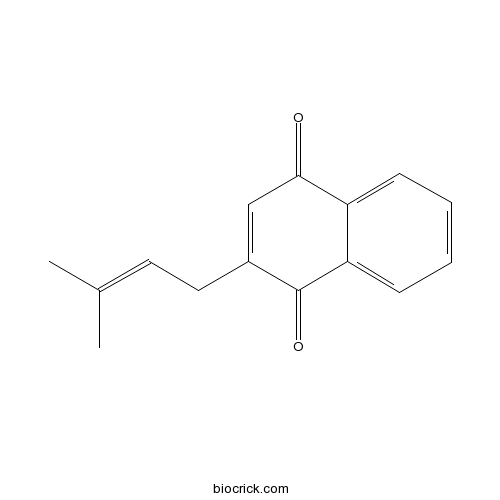DeoxylapacholCAS# 3568-90-9 |

Quality Control & MSDS
3D structure
Package In Stock
Number of papers citing our products

| Cas No. | 3568-90-9 | SDF | Download SDF |
| PubChem ID | 97448 | Appearance | Yellow oil |
| Formula | C15H14O2 | M.Wt | 226.3 |
| Type of Compound | Quinones | Storage | Desiccate at -20°C |
| Solubility | Soluble in Chloroform,Dichloromethane,Ethyl Acetate,DMSO,Acetone,etc. | ||
| Chemical Name | 2-(3-methylbut-2-enyl)naphthalene-1,4-dione | ||
| SMILES | CC(=CCC1=CC(=O)C2=CC=CC=C2C1=O)C | ||
| Standard InChIKey | OSDFYZPKJKRCRR-UHFFFAOYSA-N | ||
| Standard InChI | InChI=1S/C15H14O2/c1-10(2)7-8-11-9-14(16)12-5-3-4-6-13(12)15(11)17/h3-7,9H,8H2,1-2H3 | ||
| General tips | For obtaining a higher solubility , please warm the tube at 37 ℃ and shake it in the ultrasonic bath for a while.Stock solution can be stored below -20℃ for several months. We recommend that you prepare and use the solution on the same day. However, if the test schedule requires, the stock solutions can be prepared in advance, and the stock solution must be sealed and stored below -20℃. In general, the stock solution can be kept for several months. Before use, we recommend that you leave the vial at room temperature for at least an hour before opening it. |
||
| About Packaging | 1. The packaging of the product may be reversed during transportation, cause the high purity compounds to adhere to the neck or cap of the vial.Take the vail out of its packaging and shake gently until the compounds fall to the bottom of the vial. 2. For liquid products, please centrifuge at 500xg to gather the liquid to the bottom of the vial. 3. Try to avoid loss or contamination during the experiment. |
||
| Shipping Condition | Packaging according to customer requirements(5mg, 10mg, 20mg and more). Ship via FedEx, DHL, UPS, EMS or other couriers with RT, or blue ice upon request. | ||
| Description | 1. Deoxylapachol from T. grandis extract can induce fungal cell wall stress. 2. Deoxylapachol has anti-wood rot activity, it can inhibit the brown rot fungi Gloeophyllum sepiarium CBS 353.74 and Gloeophyllum trabeum CBS 318.50 and the white rot fungi Merulius tremellosus CBS 280.73 and Phlebia brevispora CBS 509.92. |
| Targets | Antifection |

Deoxylapachol Dilution Calculator

Deoxylapachol Molarity Calculator
| 1 mg | 5 mg | 10 mg | 20 mg | 25 mg | |
| 1 mM | 4.4189 mL | 22.0946 mL | 44.1891 mL | 88.3783 mL | 110.4728 mL |
| 5 mM | 0.8838 mL | 4.4189 mL | 8.8378 mL | 17.6757 mL | 22.0946 mL |
| 10 mM | 0.4419 mL | 2.2095 mL | 4.4189 mL | 8.8378 mL | 11.0473 mL |
| 50 mM | 0.0884 mL | 0.4419 mL | 0.8838 mL | 1.7676 mL | 2.2095 mL |
| 100 mM | 0.0442 mL | 0.2209 mL | 0.4419 mL | 0.8838 mL | 1.1047 mL |
| * Note: If you are in the process of experiment, it's necessary to make the dilution ratios of the samples. The dilution data above is only for reference. Normally, it's can get a better solubility within lower of Concentrations. | |||||

Calcutta University

University of Minnesota

University of Maryland School of Medicine

University of Illinois at Chicago

The Ohio State University

University of Zurich

Harvard University

Colorado State University

Auburn University

Yale University

Worcester Polytechnic Institute

Washington State University

Stanford University

University of Leipzig

Universidade da Beira Interior

The Institute of Cancer Research

Heidelberg University

University of Amsterdam

University of Auckland

TsingHua University

The University of Michigan

Miami University

DRURY University

Jilin University

Fudan University

Wuhan University

Sun Yat-sen University

Universite de Paris

Deemed University

Auckland University

The University of Tokyo

Korea University
- Fmoc-Leu-OH
Catalog No.:BCC3509
CAS No.:35661-60-0
- Fmoc-Phe-OH
Catalog No.:BCC3535
CAS No.:35661-40-6
- Fmoc-Ala-OH
Catalog No.:BCC3034
CAS No.:35661-39-3
- SB525334
Catalog No.:BCC2531
CAS No.:356559-20-1
- SB-505124 hydrochloride
Catalog No.:BCC1930
CAS No.:356559-13-2
- NSC 3852
Catalog No.:BCC2423
CAS No.:3565-26-2
- Benzbromarone
Catalog No.:BCC4634
CAS No.:3562-84-3
- Mesuaxanthone A
Catalog No.:BCN5298
CAS No.:3561-81-7
- CP 20961
Catalog No.:BCC6063
CAS No.:35607-20-6
- N-Desethyl Sunitinib
Catalog No.:BCC1792
CAS No.:356068-97-8
- Toceranib
Catalog No.:BCC2005
CAS No.:356068-94-5
- Darapladib
Catalog No.:BCC1515
CAS No.:356057-34-6
- Dihydrobaicalein
Catalog No.:BCN3887
CAS No.:35683-17-1
- Questinol
Catalog No.:BCN7443
CAS No.:35688-09-6
- Valerenic acid
Catalog No.:BCC7546
CAS No.:3569-10-6
- Naloxone HCl
Catalog No.:BCC4612
CAS No.:357-08-4
- Brucine
Catalog No.:BCN2390
CAS No.:357-57-3
- Galantamine
Catalog No.:BCN2868
CAS No.:357-70-0
- Albaspidin AA
Catalog No.:BCN5300
CAS No.:3570-40-9
- Moslosooflavone
Catalog No.:BCN5301
CAS No.:3570-62-5
- Pemetrexed disodium hemipenta hydrate
Catalog No.:BCC1844
CAS No.:357166-30-4
- Tropanyl trans-cinnamate
Catalog No.:BCN1931
CAS No.:35721-92-7
- BMS-378806
Catalog No.:BCC4505
CAS No.:357263-13-9
- Hygrophylline
Catalog No.:BCN2116
CAS No.:3573-82-8
Activity of quinones from teak (Tectona grandis) on fungal cell wall stress.[Pubmed:16972200]
Planta Med. 2006 Aug;72(10):943-4.
Teak ( Tectona grandis L.f., Verbenaceae) sawdust extract inhibited the growth of Aspergillus niger. Centrifugal partition chromatography was used to isolate the active compounds. By (1)H-NMR the active compounds were identified as Deoxylapachol and tectoquinone. Two A. niger transgenic strains which show induction of 1,3 -alpha-D-glucan synthase were used as a cell wall damage model. The result showed that Deoxylapachol from T. grandis extract induced fungal cell wall stress.


